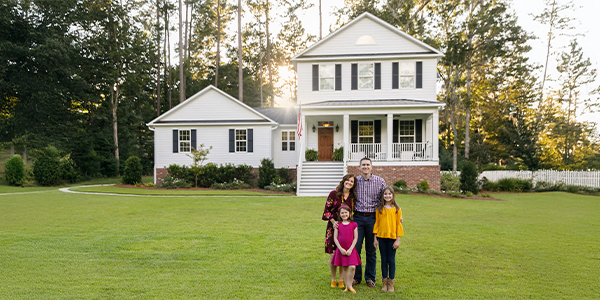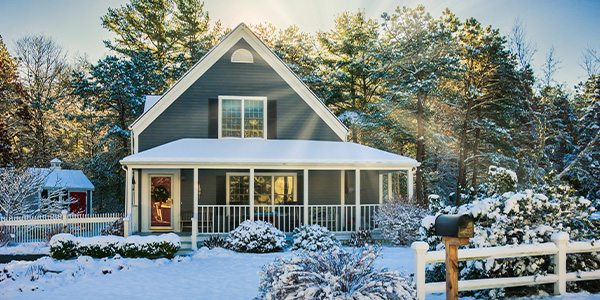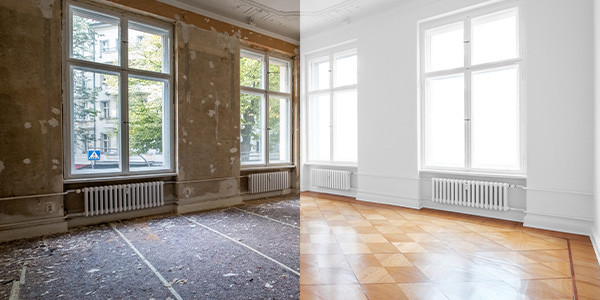Homebuyers
How to Upsize Your Home without Breaking the Bank
May 30, 2025
Many owners may daydream about eventually buying a bigger home with a finished basement and an extra powder room.
For other homeowners, upsizing to a larger home is simply a necessity with a ticking clock. You may have a growing family that can no longer comfortably fit in your starter home, you need a dedicated home office, or perhaps you simply crave a little more breathing room. In that case, upsizing your home can feel like the natural next step.
But trading up to a home with more square footage isn’t always as simple as picking a bigger place and calling the movers.
Like all things real estate, upsizing may need some careful thought. And to do a move-up home right—without overreaching your budget or settling for the wrong home—you’ll need a strategy. Here’s what buyers should consider before leaping into larger living quarters.
Define what upsizing means for you
A new home with room to roam doesn’t always involve moving to the suburbs or more rural areas. For some owners, the perfect upsize could mean trading a cramped two-bedroom apartment for a three-bedroom condo.
For others, upsizing might mean a larger lot with room for a garden, a pool, or a play set. So, before you browse the listing pages, think beyond simply greater square footage to usage and needs.
Do you need more bedrooms? Another bathroom? A finished basement for your family to use as a playroom? Or do you simply want some of these things?
Your definition of “upsize” should be tailored to your lifestyle, not simply the size or amenities of a home.
Know the actual cost of upsizing

Yes, a bigger home usually means a heftier price tag. But budget concerns don’t stop at the closing price. Potentially higher mortgage payments are only part of the financial picture.
More space often brings higher property taxes, utility bills, maintenance costs, and homeowners insurance.
“When upsizing, buyers often go bigger than necessary,” said Betsy Ronel, an associate broker at Coldwell Banker Global Luxury in Katonah, N.Y. Some buyers can get “myopic and focus on one thing, say a number of bedrooms, and end up in this very large home or extensive property with very high taxes or running costs.”
To combat buying a wallet-busting, trade-up home, create a sample monthly budget for the kind of home you’re targeting.
Use online mortgage calculators or ask your lender for an estimate based on homes currently on the market. Then research the cost of maintaining the home so you have a complete financial picture before making an offer.
Think about how your needs will evolve

It’s tempting to upsize based on your current pain points—the toddler toys taking over your cramped living room or the lack of a guest bedroom. But a smart approach to an upsize factors in how your life might change (yet again) in the next five to 10 years.
Is your family growing? Are you considering aging-in-place features for the long term? Could a parent or in-law eventually move in?
“When discussing a home with a buyer, I like to emphasize that the decision should be with a long-term focus,” said Bruce Ailion of Atlanta’s RE/MAX Town and Country.
A well-considered upsize can help you stay put longer—and avoid multiple moves that cost time and money.
Don’t get lured by unnecessary extras
Home hunters upsizing from starter homes can get wide-eyed when they step into homes with media rooms, wine cellars, or spa showers. But remember: every bonus feature adds to your monthly costs.
If you rarely use that upstairs library or extra garage bay, you might be better off skipping those types of extras.
Try this tip to help you stay on the practical side of upsizing. Create two lists—must-haves and nice-to-haves—and don’t let the second list overpower the first as you shop for a new home.
Explore further-out neighborhoods

One of the most significant barriers to upsizing is location. The area where you bought your first home might be out of your price range when you are looking for more space.
But that doesn’t mean you have to stay put.
Consider homes a little farther from downtown or those that haven’t hit peak pricing yet.
You might even find newer builds at a lower price point that offers additional square footage, giving you more bang for your buck.
On the other hand, be wary of new, expensive builds that are priced higher than other homes in the neighborhood.
“They may overestimate their needs and end up with a property or a home that ultimately is too much for them or unaffordable to maintain,” said Ronal.






 Smart Moves Start Here.
Smart Moves Start Here.